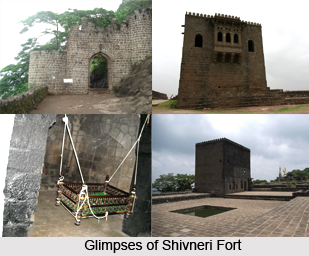 Shivneri Fort is one of the important military fortifications of Maratha Empire which is located at a distance of 3 kms from Junnar and 125 kms from Pune. Shivneri fort is also known as the birthplace of Chhatrapati Shivaji. As the state was facing continuous threat of war, Shahaji the father of Shivaji shifted his family to the Shivneri Fort. Shahaji was a general in the army of Adil Shah who was the Sultan of Bijajur. Shahaji`s major concern was the security of Jijabai, mother of Shivaji as she was pregnant. In order to avoid enemy attack he shifted his wife and their unborn baby to Shivneri fort which is popularly known for its strategic importance and architecture.
Shivneri Fort is one of the important military fortifications of Maratha Empire which is located at a distance of 3 kms from Junnar and 125 kms from Pune. Shivneri fort is also known as the birthplace of Chhatrapati Shivaji. As the state was facing continuous threat of war, Shahaji the father of Shivaji shifted his family to the Shivneri Fort. Shahaji was a general in the army of Adil Shah who was the Sultan of Bijajur. Shahaji`s major concern was the security of Jijabai, mother of Shivaji as she was pregnant. In order to avoid enemy attack he shifted his wife and their unborn baby to Shivneri fort which is popularly known for its strategic importance and architecture.
Shivneri fort is still one of the most important structures of Maratha Empire which has been recognized for its military location. With the well built strongest boundary walls this fort is considered to be the most secured fort in the Maratha Empire. Shivaji was born on 19th February 1630 and spent his entire childhood in this fort. The fort also includes a small temple which is dedicated to goddess Shivai Devi after whom Shivaji received his name. The fort also includes the statues of Jijabai and young Shivaji which are placed towards the southern part of a small lake called Badami talab. The lake is centrally located inside the fort which receives water from the two streams called Ganga -Jamuna that flow in front of the fort. Two kilometres away from the fort is the Leyadri caves which are known for the famous Ashtavinayaka temples of Maharashtra.
Shivneri fort is one of the most prominent forts of Maharashtra which is known for its architecture. Built with military strategy the fort is surrounded with strong walls and passes through seven large gates to reach the actual fort. The fort has a wide base towards the south and a narrow point towards the north. The entrance is protected with strong gates and strong boundary walls which protect the fort from all sides. All the seven gated of the fort are marked by some unique feature. Most exceptional is the fifth gate which is armoured by anti elephant spikes. Though largely turned into ruins the fort includes some prominent buildings like a mosque made by the Mughals and the house where Shivaji was born. With general maintenance of the fort, the House where Shivaji was born has been renovated along with the statues of Jijabai and young Shivaji.
The fort is located at a distance of 3 kms from Junnar- one of the oldest cities of ancient India. This little township came under the rule of the Shankhya dynasty which was followed by the rule of the Satavahana dynasty. This place includes some of the most prominent caves of ancient India which can be dated back to 2nd and 3rd century BC. After the Satavahanas the Shivneri was occupied by Shilaharas, the Yadavas, the Bahamanis and the Mughals who ruled the area from time to time. The rule of all these dynasties has left some symbol of their presence which is reflected in the architecture of the fort. Though Shivaji was born in this fort he had to surrender this to the Mughals who captures it during their reign. He remained unsuccessful in regaining this in all his lifetime. The fort was recaptured by the Marathas under the leadership of Shahu Maharaj who brought it under the control of the Peshwas.
The grandeur of the Shivneri fort is surrounded with some other important forts like Harishchandragad, Junnar and Jivadhan which has its own strategic importance. With some well connected roadways and bus routes the place can be visited from Mumbai, Kalyan and Pune.
Thus as one of the well built forts in Mumbai this is often visited by the tourists. This fort defines the great military strategy of the Marathas which is reflected in the architecture of the fort.



















